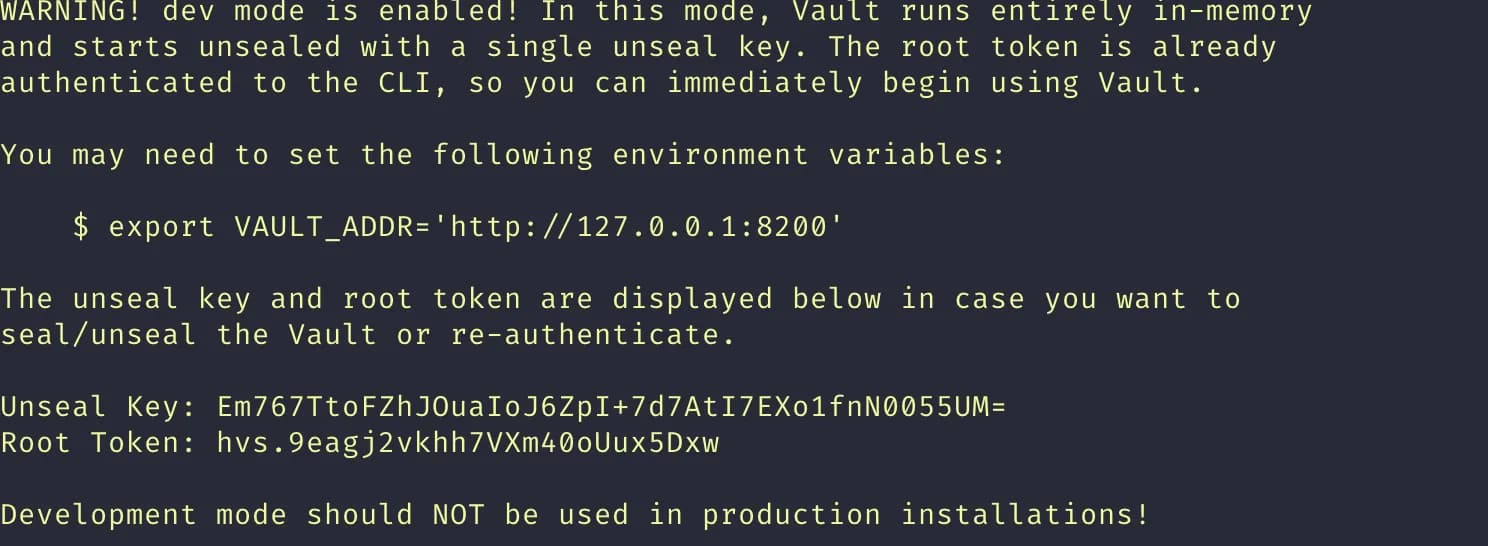Setup
I’ll be using CATS to do API fuzzing. You can get a 1 minute intro to CATS here: Get Started in 1 minute tutorial. The fuzzing will have 2 parts:
- part 1 (this article) is doing a blackbox fuzzing i.e. provide just access token without additional context
- part 2 (future article) will do more context-driven fuzzing i.e. I’ll do some data setup before and do the fuzzing with additional context
Vault is freshly installed and I don’t have any setup or context for it.
I have CATS installed:

I have Vault installed:

I have the Vault OpenAPI file saved as api.json.
Let’s start Vault in dev mode:
vault server -dev
Export the Root Token as an environment variable:
export token=hvs.9eagj2vkhh7VXm40oUux5DxwAccording to the Get Started in 1 minute tutorial, we are now ready to run CATS.
Run
Run CATS in blackbox mode:
cats --contract=api.json --server=http://localhost:8200/v1 -H "X-Vault-Token=$token" -b After 11 minutes I get the following results:
- 26314 successful tests (success in blackbox mode means not
500) - 165 errors (i.e.
500)

Findings
Read timeouts
Many requests done on /sys/pprof/profile result in read timeout. It’s not clear what happens, as there is nothing present in the logs.
To reproduce this, I can take any of the failing tests for this path and do a replay: cats replay Test31142.
Socket hangups resulting in connection failures
Multiple requests are causing connection failures:
POSTon/sys/leases/lookupwith
{
"lease_id": null
}POSTon/sys/leases/with
{
"url_lease_id": "mY77mev5F2AZ7Mbd",
"increment": 2,
"lease_id": null
}POSTon/sys/leases/revokewith
{
"url_lease_id": "uo6etjzzBKOsuN",
"sync": true,
"lease_id": null
}They all result in connection errors.
The logs show the following:
[INFO] http: panic serving 127.0.0.1:57259: interface conversion: interface {} is nil, not string
goroutine 54353 [running]:
net/http.(*conn).serve.func1()
/opt/hostedtoolcache/go/1.19.3/x64/src/net/http/server.go:1850 +0xbf
panic({0x595efa0, 0xc0019c49f0})
...Same connection failure, but with a different cause, by doing a DELETE on /identity/mfa/login-enforcement/2haK9t2O. This is the log:
[INFO] http: panic serving 127.0.0.1:57352: runtime error: invalid memory address or nil pointer dereference
goroutine 54900 [running]:
net/http.(*conn).serve.func1()
/opt/hostedtoolcache/go/1.19.3/x64/src/net/http/server.go:1850 +0xbf
panic({0x58dcca0, 0xa521930})
/opt/hostedtoolcache/go/1.19.3/x64/src/runtime/panic.go:890 +0x262
...Some confusing errors and behaviour
Example 1
The /identity/group/name/{name} endpoint has some strange and inconsistent behaviour with confusing errors:
- I get
204on aDELETEeven though thenamedoes not exist. I would expect a404here. - When I do a
POSTwith a full payload, like:
{
"member_group_ids": [
"yEBjQD3UJvZn5ySGXTT",
"yEBjQD3UJvZn5ySGXTT"
],
"metadata": {
"key": "value",
"anotherKey": "anotherValue"
},
"policies": [
"OOOOOOOOOOO",
"OOOOOOOOOOO"
],
"id": "071",
"type": "y6R7Vt9",
"member_entity_ids": [
"8kGuW9WE2ww4xI8X9bRn",
"8kGuW9WE2ww4xI8X9bRn"
]
}I get a 400:
{
"errors": [
"group type cannot be changed"
]
}But again, the group doesn’t exist. I would expect a 404. And if the type cannot be changed, why I’m able to send it in the request?
And it gets weirder. When the type is removed by the RemoveFieldsFuzzer, I get a 500 error:
{
"errors": [
"1 error occurred:\n\t* invalid entity ID \"8kGuW9WE2ww4xI8X9bRn\"\n\n"
]
}I would expect something around 4XX. The group still doesn’t exist.
Example 2
If I do a POST on /sys/capabilities with:
{
"path": [
"DnsnmZ",
"DnsnmZ"
],
"paths": [
"nxKLCAgp",
"nxKLCAgp"
],
"token": ""
}I get a 500 with:
{
"errors": [
"1 error occurred:\n\t* no token found\n\n"
]
}But if I send a value within the token field:
{
"path": [
"DnsnmZ",
"DnsnmZ"
],
"paths": [
"nxKLCAgp",
"nxKLCAgp"
],
"token": "ZUXO3Mk"
}I get a 400:
{
"errors": [
"1 error occurred:\n\t* invalid token\n\n"
]
}Again, inconsistent. I would still go with a consistent 4XX response for all cases.
Unexpected HTTP response codes
Multiple endpoints will return 500 instead of 4XX (which I would consider more suitable for those cases).
500 should usually be reserved for unexpected behaviour during server side processing, rather than predictable business errors.
For example, a POST on /sys/config/cors with
{
"allowed_headers": [
"AaiFkW79i80SuaXTFT0",
"AaiFkW79i80SuaXTFT0"
],
"enable": true
}Will return a 500:
{
"errors": [
"1 error occurred:\n\t* at least one origin or the wildcard must be provided\n\n"
]
}This is clearly a validation issue, which the API user can correct.
A GET on /internal/counters/activity/export will return a 500:
{
"errors": [
"1 error occurred:\n\t* no data to export in provided time range\n\n"
]
}Bypassing authentication for a GET on /sys/internal/ui/namespaces will result in a 500 rather than a 403:
{
"errors": [
"client token empty"
]
}For all these cases I would go for 4XX for consistency and also better monitoring of the service.
If the API returns 500 for validation issues, it will be hard do differentiate between cases when something goes really wrong and 500 is a signal of a real processing issue.
A GET on /sys/policies/password/FZhyI/..%20;/ will result in a 500:
{
"errors": [
"1 error occurred:\n\t* failed to retrieve password policy\n\n"
]
}This is confusing. Is the 500 because the policy was not found? Was there an issue while retrieving and processing it? Hard to say.
Rest of the errors are caused by namespace not being found. Some examples: cats replay Test37474, cats replay Test442. I would, again, expect a 404 as the namespace was not found.
Final thoughts
This is the end of part 1. Part 2 will continue with fuzzing with context i.e. creating a bunch of data (namespace, token, group etc) and use that as a context for fuzzing.
Most important issues are raised on GitHub: